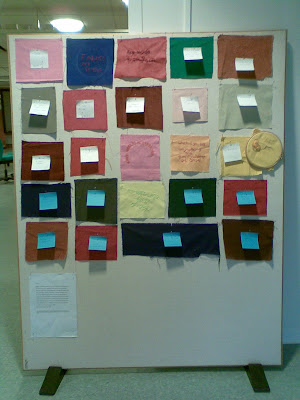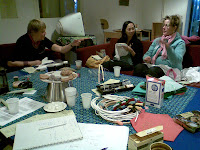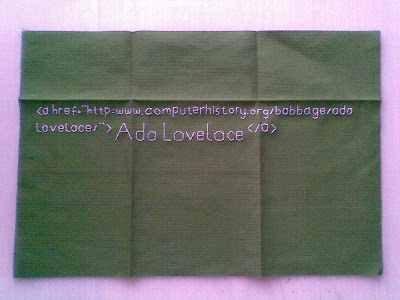Okay - I'll be honest here. There's a dropped stitch of an idea in Open Source Embroidery Fika here in Umeå, which I keep trying to pick up. It is this: OSE only works when it is inter-disciplinary, when people bring hardware and knitware, softwear and code-wear. Otherwise it's just tech, or just textiles (and we know the gender cliques they hide within). Although OSE Fika has made some progress in convincing embroiderers not to be scared of the tech threads, and reassuring the tech-iles not to be put-off by the text-iles, there's a lot more work to be done. We need confidence in taking things apart, questioning the ethics, the access, the utopian and dystopian models we are emulating.
As inspiration - take Aileen Derieg's essay Things Can Break: Tech Women Crashing Computers and Preconceptions. She gives an overview of women and open source, and an introduction to the Genderchangers Academy.
Saturday, November 29, 2008
Wednesday, November 19, 2008
Stitching the Yarn Text
 The Open Source Embroidery (OSE) Fika groups have fostered some interesting starting points of conversations about craft practices grappling with the idea of Open Source or what Camille Mousette called an 'open attitude'.
The Open Source Embroidery (OSE) Fika groups have fostered some interesting starting points of conversations about craft practices grappling with the idea of Open Source or what Camille Mousette called an 'open attitude'. 
But our discussions are fragmented across different sites and individual creative projects. I feel that there is a need to bring together the different threads within a collective work which explores the material nature of technology. So I have proposed a collectively embroidered and short text that I keep referencing: the Raqs Media Collective definition of 'Yarn'from their Lexicon of/for the Digital Commons. I think this stitched text will visually consolidate one aspect of what OSE means in relation to HUMlab and the language of new media.
In yesterdays OSE Fika we set up a paper document for people to choose the line of text they would like to embroider, and started stitching on the fabric swatches that the aesthetics department gave me in return for a lecture.
The design board for the patchwork is at HUMlab (see photo above). If you are in Umea and would like to make a patch, the text and stitchers list is available next to the design board in HUMlab, underneath the library in the Humanities building.
Sunday, November 16, 2008
Common Humanity
I'm reading Andrew Brown's memoir of his experience of Sweden from the 1970s to the present. He makes an interesting analogy between democracy, common humanity and craft circles. In Swedish a sewing circle or group is called Syjunta.
“… close to what Swedes mean by democracy: not a voting system, but a recognition of common humanity. This was the spirit that had lain behind all the craft circles and evening classes and even the passionate fishing clubs of which I had been a member.”
Andrew Brown, 2008, Fishing in Utopia: Sweden and the Future that Disappeared, Granta Books: London. p255-256
One of the remarkable experiences of the Open Source Embroidery Fika meetings is that women who haven't been able to pick up a needle and thread for ten, twenty, or even thirty years, are finding an empowered space in which they can stitch without fear of betraying their feminist principles. The recognition of 'common humanity' which we associate with the 1970s craft movement is being reinvented, bringing together women of different ages, with a mixture of intellectual and social interests. But today the language used to invigorate a culture of making, is entwined with the utopian vision of the power of social networks using the internet as our communications web.
“… close to what Swedes mean by democracy: not a voting system, but a recognition of common humanity. This was the spirit that had lain behind all the craft circles and evening classes and even the passionate fishing clubs of which I had been a member.”
Andrew Brown, 2008, Fishing in Utopia: Sweden and the Future that Disappeared, Granta Books: London. p255-256
One of the remarkable experiences of the Open Source Embroidery Fika meetings is that women who haven't been able to pick up a needle and thread for ten, twenty, or even thirty years, are finding an empowered space in which they can stitch without fear of betraying their feminist principles. The recognition of 'common humanity' which we associate with the 1970s craft movement is being reinvented, bringing together women of different ages, with a mixture of intellectual and social interests. But today the language used to invigorate a culture of making, is entwined with the utopian vision of the power of social networks using the internet as our communications web.
Tuesday, November 11, 2008
Den Röda Tråden
The OSE Fika discussion at HUMlab this afternoon focused on the material physicality of the internet and technology woven together through a web of cable which stretches across countries and across the seabed to connect continents.
Sadie Plant writes:
“Media has become interactive and hyperactive, the multiplicitous components of an immersive zone which does not begin with writing; it is directly related to the weaving of elaborate figured silks. The yarn is neither metaphorical nor literal, but quite simply material, a gathering of threads which twist and turn through the history of computing, technology, the sciences and the arts.” (Sadie Plant, 1997, Zeros + Ones, p12)
We also discussed the Raqs Media Collectives' definition of Yarn, and the way in which data cables as well as knitted yarns can carry a story. Den Röda Tråden – is the red thread which weaves through a story or an argument. In English we speak of the 'thread' of an argument, but it doesn't have a specific colour.
Red thread is also a potent emblem in a Chinese proverb - where the red thread is said to connect everyone that will ever meet. I rather like this parasitic red thread project by Stromgasse.
On a more practical note - after several failed attempts to convert the HUMlab logo into a cross stitch pattern using online software, Haishu printed out a grid and is drawing her pattern by hand, her thread is not red or pink, but deep magenta.
Artist Margareta Klingberg brought along the amazing Fiber Art Sweden catalogue. If you want to read more, I'll bring along to the OSE Fika at the Art school on Thursday 14.00 - 17.00.
Sadie Plant writes:
“Media has become interactive and hyperactive, the multiplicitous components of an immersive zone which does not begin with writing; it is directly related to the weaving of elaborate figured silks. The yarn is neither metaphorical nor literal, but quite simply material, a gathering of threads which twist and turn through the history of computing, technology, the sciences and the arts.” (Sadie Plant, 1997, Zeros + Ones, p12)
We also discussed the Raqs Media Collectives' definition of Yarn, and the way in which data cables as well as knitted yarns can carry a story. Den Röda Tråden – is the red thread which weaves through a story or an argument. In English we speak of the 'thread' of an argument, but it doesn't have a specific colour.
Red thread is also a potent emblem in a Chinese proverb - where the red thread is said to connect everyone that will ever meet. I rather like this parasitic red thread project by Stromgasse.

On a more practical note - after several failed attempts to convert the HUMlab logo into a cross stitch pattern using online software, Haishu printed out a grid and is drawing her pattern by hand, her thread is not red or pink, but deep magenta.
Artist Margareta Klingberg brought along the amazing Fiber Art Sweden catalogue. If you want to read more, I'll bring along to the OSE Fika at the Art school on Thursday 14.00 - 17.00.
Friday, November 07, 2008
Translating Stitches
 Artists and designers in Umea joined fine art students and an interaction designer and writer at the OSE Fika at the Konsthogskolan on Thursday. There was an interesting discussion about possible connections between object based programming and creating a knitted object... so we'll see what happens.
Artists and designers in Umea joined fine art students and an interaction designer and writer at the OSE Fika at the Konsthogskolan on Thursday. There was an interesting discussion about possible connections between object based programming and creating a knitted object... so we'll see what happens.Whilst computer code is always in English, knitting patterns use language specific abbreviations. Suzanne has taken on the ambitious project of knitting a cover for one of the giant flat-screens in HUMlab. The knit will include letters describing the knitting pattern for the cover. Charlene has just moved to Umea from the US and is stitching her new Swedish vocabulary by hand.
For the OSE Fika at the Art School on November 13th we will be joined by interaction designer Camille Moussette, who is an advocate of Open Source in his work. Camille is currently doing research at the Umea Institute of Design. See his HAPI project.
Wednesday, November 05, 2008
Coding a Trousseau
 The first Open Source Embroidery Fika in HUMlab was a cosy affair. I gave a talk about the OSE project, and Stefanie Wuschitz talked about why she uses open source mobile processing software for her work. To find out more go along to Miss Balthazar's Laboratory.
The first Open Source Embroidery Fika in HUMlab was a cosy affair. I gave a talk about the OSE project, and Stefanie Wuschitz talked about why she uses open source mobile processing software for her work. To find out more go along to Miss Balthazar's Laboratory.Johan described the programmers pride in their work, and the difference between neat and sloppy code. If you make your code public through open source, then you want it to be your best. We compared this pride with the tradition of making a sample craft project to show-off your skills. Such as women making an embroidery sampler, or men whittling a love spoon, to prove their talents to future partners. Maybe neat coding will be the new trousseau!
Sunday, November 02, 2008
Ada Lovelace
Ada Lovelace (1815 - 1852) was an analyst and metaphysician and is often referred to as the first computer programmer. She worked with Charles Babbage on the Analytical Engine, the precursor to the modern computer. Lovelace made extensive notes accompanying the engine, in which she describes how it could be programmed, and the broader scope of its potential. She wrote:
"The distinctive characteristic of the Analytical Engine, and that which has rendered it possible to endow mechanism with such extensive faculties as bid fair to make this engine the executive right-hand of abstract algebra, is the introduction into it of the principle which Jacquard devised for regulating, by means of punched cards, the most complicated patterns in the fabrication of brocaded stuffs. It is in this that the distinction between the two engines lies. Nothing of the sort exists in the Difference Engine. We may say most aptly that the Analytical Engine weaves algebraical patterns just as the Jacquard loom weaves flowers and leaves."
P Morrison and E Morrison (eds.), Charles Babbage and his calculating engines (New York, 1961).
I've embroidered the hyperlink that enables you to jump from this page to the web page about Ada Lovelace on the Computer History Museum's website by clicking on the words 'Ada Lovelace' above.
"The distinctive characteristic of the Analytical Engine, and that which has rendered it possible to endow mechanism with such extensive faculties as bid fair to make this engine the executive right-hand of abstract algebra, is the introduction into it of the principle which Jacquard devised for regulating, by means of punched cards, the most complicated patterns in the fabrication of brocaded stuffs. It is in this that the distinction between the two engines lies. Nothing of the sort exists in the Difference Engine. We may say most aptly that the Analytical Engine weaves algebraical patterns just as the Jacquard loom weaves flowers and leaves."
P Morrison and E Morrison (eds.), Charles Babbage and his calculating engines (New York, 1961).
I've embroidered the hyperlink that enables you to jump from this page to the web page about Ada Lovelace on the Computer History Museum's website by clicking on the words 'Ada Lovelace' above.

Subscribe to:
Posts (Atom)